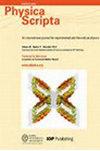从配备全钨分流器的 EAST 托卡马克观测到的 10-480 Å 极紫外范围钨光谱的光谱分析
IF 2.6
3区 物理与天体物理
Q2 PHYSICS, MULTIDISCIPLINARY
引用次数: 0
摘要
利用四台快速时间响应超紫外分光计(EUV_Short (5-45 Å)),在带有全钨分流器的实验性先进超导托卡马克(EAST)中观测了10-480 Å波长范围内的高温等离子体钨光谱、和 EUV_Long_b(270-480 Å),以及两台空间分辨式 EUV 光谱仪,即 EUV_Short2_d(45-70 Å)和 EUV_Long2_d(40-130 Å)。测量光谱的波长是根据低 Z(He、Li、C、N 和 O)、中 Z(Fe 和 Cu)和高 Z(Mo)杂质离子发射的几条著名光谱线精确校准的。对钨光谱的测量来自伴随瞬态钨迸发事件的放电,该事件会产生钨原子脉冲涌入 EAST 等离子体。通过钨线强度的时间行为和径向剖面分布,对迸发事件前后观测到的钨光谱进行了仔细分析。结果,在钨爆发后观测到的光谱中成功确认了 213 条钨线,并将结果汇总在表格中。这些钨线包括 10-140 Å 处 W XXIII - W XLVI (W22+ - W45+) 的 78 条线和 160-480 Å 处 W V - W IX (W4+ - W8+) 的 88 条线,而 50-380 Å 处的 47 条钨线则无法明确过渡。此外,还在 18-38 Å、45-70 Å 和 150-280 Å 三个波长范围内分析了钨离子在低电离阶段和高电离阶段的准连续谱,称为未分辨转变阵列(UTA),其中 W XXIII - W XXXVIII(W22+ - W37+)、W XXVII - W XLVI(W26+ - W45+)和 W VI-W IX(W5+ - W8+)分别在这三个波长范围内主要发射。通过分析发现,140-220 Å 处钨UTA 的电荷状态分布随着电子温度的降低而显著变化。通过比较径向强度曲线和电子温度曲线,实验再次证实了所有观测到的钨线(包括孤立线和准连续线)的电离阶段。最后,选择了对聚变等离子体中的钨诊断有用的光谱线,并在表中标出。本文章由计算机程序翻译,如有差异,请以英文原文为准。
Spectroscopic analysis of tungsten spectra in extreme-ultraviolet range of 10-480 Å observed from EAST tokamak with full tungsten divertor
Tungsten spectra in extreme ultraviolet (EUV) wavelength range of 10-480 Å have been observed from high-temperature plasmas in Experimental Advanced Superconducting Tokamak (EAST) with full tungsten divertor using four fast-time-response EUV spectrometers of EUV_Short (5-45 Å), EUV_Long_a (40–180 Å), EUV_Long_c (130–330 Å) and EUV_Long_b (270–480 Å) and two space-resolved EUV spectrometers of EUV_Short2_d (45–70 Å) and EUV_Long2_d (40–130 Å). The wavelength of measured spectra is accurately calibrated based on several well-known spectral lines emitted from low-Z (He, Li, C, N and O), medium-Z (Fe and Cu) and high-Z (Mo) impurity ions. Measurements of the tungsten spectra were taken from discharges accompanied with a transient tungsten burst event, which creates a pulsed influx of tungsten atoms into the EAST plasma. The tungsten spectra observed before and after the burst event are carefully analyzed with temporal behavior and radial profile distribution of the tungsten line intensity. As a result, 213 tungsten lines are successfully confirmed in the spectra observed after the tungsten burst, and the results are summarized in tables. These tungsten lines include line identifications of 78 lines of W XXIII - W XLVI (W22+ - W45+) at 10–140 Å and 88 lines of W V - W IX (W4+ - W8+) at 160–480 Å, while 47 tungsten lines at 50–380 Å could not be clarified the transition. In addition, quasi-continuum spectra called unresolved transition array (UTA) from tungsten ions in low- and high-ionization stages are also analyzed in three wavelength ranges of 18–38 Å, 45–70 Å and 150–280 Å at which W XXIII - W XXXVIII (W22+ - W37+), W XXVII - W XLVI (W26+ - W45+) and W VI—W IX (W5+ - W8+) are dominantly emitted, respectively. Through the analysis it is found that charge state distributions of tungsten UTA at 140–220 Å significantly vary with decrease in the electron temperature. Ionization stages of all observed tungsten lines including both isolated and quasi-continuum lines are experimentally reconfirmed by comparing the radial intensity profile with the electron temperature profile. Finally, spectral lines useful for tungsten diagnostic in fusion plasmas are selected and marked in the tables.
求助全文
通过发布文献求助,成功后即可免费获取论文全文。
去求助
来源期刊

Physica Scripta
物理-物理:综合
CiteScore
3.70
自引率
3.40%
发文量
782
审稿时长
4.5 months
期刊介绍:
Physica Scripta is an international journal for original research in any branch of experimental and theoretical physics. Articles will be considered in any of the following topics, and interdisciplinary topics involving physics are also welcomed:
-Atomic, molecular and optical physics-
Plasma physics-
Condensed matter physics-
Mathematical physics-
Astrophysics-
High energy physics-
Nuclear physics-
Nonlinear physics.
The journal aims to increase the visibility and accessibility of research to the wider physical sciences community. Articles on topics of broad interest are encouraged and submissions in more specialist fields should endeavour to include reference to the wider context of their research in the introduction.
 求助内容:
求助内容: 应助结果提醒方式:
应助结果提醒方式:


